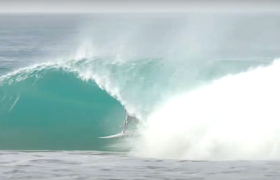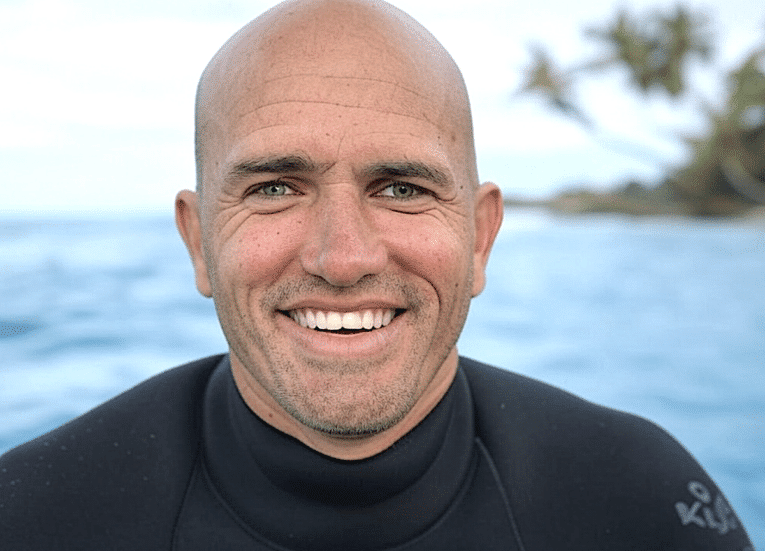"Not even a moron in a hurry would confuse these brands."
The Lost v. Lady Gaga lawsuit (not the actual case name, but we’ll roll with it given the alliterative ring it has) has done something to the surf community in only a few short days that I thought I’d never see—turning surfers into armchair lawyers.
Unsurprisingly, there has been a lot of misconception about the nature of the claims (for instance, there is no copyright claim here) and Lost’s likelihood of success, coupled with a slight misinterpretation by Chas and David Lee Scales on the latest Grit Podcast of some of the below-the-line comments I’ve made on the subject. As a surfer and a man with the misfortune of practicing law in Orange County for the better part of 20 years who has handled a fair few trademark cases, it is my responsibility to help the peoples understand what is really going on here, because this is some kook behavior by Lost and Matt Biolos if you ask me.
If you’re not inclined to read further, let me spell this out for the TLDR crew: Biolos is getting bad legal advice and Lost is almost certainly going to lose this case one way or another, whether by decision or by attrition. While this lawsuit might finally bring Lost/Mayhem’s existence to the attention of the 99.9999% of Lady Gaga fans who have never heard of Lost/Mayhem and the 99% of the members of the general public of the United States who haven’t heard of Lost/Mayhem either, all this lawsuit will accomplish is to reinforce the well-deserved stereotype that surfers are generally a bunch of clueless morons.
This article is not intended to provide legal advice and is not providing legal advice, but it might just give you practical advice on how to avoid being a kook.
The Original Mayhem (A Legendary Black Metal Band)
Before we get into the legalese and the lawsuit itself, let’s start with what was perhaps the most egregious error made on the latest Grit Podcast—Mr. Scales referring to the band Mayhem as a “death metal” band. Mayhem is a Norwegian black metal band, and referring to a black metal band as death metal is the metal scene equivalent of calling a surfer a boogie boarder.
Incidentally, I cannot believe that Netflix hasn’t made a mini-series about this band given that its history includes multiple church burnings, a suicide, and a murder. Nevertheless, keep the metal band Mayhem in mind, as it will become important later in this article given that it was founded in 1984, has been selling t-shirts displaying the name “Mayhem” for decades, and Biolos has never squawked about that even once.
Wow, That Mayhem Band Is Kind Of Rad, But What Exactly Is A Trademark?
A trademark is a word, phrase, symbol, or design that identifies a business owner’s goods or services, and distinguishes those goods or services from others. There are varying levels of the strength of these marks ranging from “fanciful” (made-up words like Rolex and the strongest category of trademarks) to “generic” (if you opened a coffee shop and named it “The Coffee Shop,” which wouldn’t even be able to be registered on the federal level in the United States).
Where the use of the word “Mayhem” lies is in a middle category known as an “arbitrary” mark. This is an everyday word that has no association with the goods or services themselves. The quintessential example of this is “Apple” for computers. Because the word has no association with the goods or services, it is possible for the same word mark to be used by multiple different businesses for different kinds of goods and services without infringing. For instance, “Viking” is a word mark used by multiple different companies and is the subject of multiple different federal registrations for things such as cruise ships and book publishing.
The key here with respect to trademark infringement is whether there is a likelihood of confusion by the people who would be consuming these goods or services. That doesn’t always happen where two marks are identical. For example, someone could be on a Viking cruise ship reading a book published by Viking books, yet understand full-well that the source or sponsorship of the cruise is not the same source or sponsorship of the book.
Trademark Infringement and Trademark Dilution
Trademark infringement comes down to three things: 1) the plaintiff has to own the mark; 2) the defendant has to use the same or similar mark in commerce; and 3) the defendant’s use of the mark causes a likelihood of confusion between the defendant’s mark and the plaintiff’s mark.
What is likelihood of confusion? This is when consumers viewing the defendant’s mark would probably assume that the product or service it represents is associated with the source of the plaintiff’s mark. This is much easier to prove when the plaintiff and the defendant are direct competitors (Lost and Lady Gaga certainly are not).
When the plaintiff and defendant aren’t direct competitors, things get a little more complex, and it becomes more difficult for the plaintiff to prove trademark infringement absent some actual evidence of consumer confusion and other factors such as an intent to copy and the use of the same marketing channels.
Trademark dilution, on the other hand, is a different claim that has nothing to do with a likelihood of confusion. This when there is a famous mark (e.g., Budweiser) and there is an unauthorized use of the mark that is that is likely to weaken the distinctive quality of, or harm a famous mark (e.g., a surfboard manufacturer using Budweiser’s stylized logo and font in an Instagram post to advertise their new “Ripper” board model). Importantly, a “famous mark” must be something that is widely recognized by the general consuming public of the United States. This certainly is not Lost/Mayhem.
The Practical Realities Of A Trademark Lawsuit
You can get damages for your lost profits and other harm you experience as a result of trademark infringement. You can also get the defendant’s profits from the sale of the infringing goods or services. But the remedy that has the most teeth is injunctive relief. In short, this is a court order that prevents the defendant from selling or distributing the infringing products.
This really changes the trajectory of a trademark lawsuit when there is a “preliminary injunction” at the early stages of a lawsuit. In short, it is possible to get a court order preventing the defendant from selling or distributing the infringing goods or services straight out of the gate that lasts the entire duration of the lawsuit, even if the ultimate verdict or decision is that there was no infringement.
Though it’s a very high bar to meet that requires evidence of irreparable harm to the plaintiff and a likelihood of success in the underlying case, the consequences of a preliminary injunction can be devastating for a defendant that has already incurred overhead and operational expense for products or services that it is unable to sell. That can sometimes be the death knell of the defendant’s entire business, and at the very least, it might financially burden the defendant if the infringing products or services were a significant part of its cash flow. So, in most instances, a preliminary injunction against the defendant effectively ends the lawsuit and forces an early settlement.
All that being said, a motion for preliminary injunction can backfire against a plaintiff if it isn’t granted. This is because the court has essentially made a finding that you haven’t shown that you are likely to prevail on your underlying claims and you haven’t shown sufficient actual or threatened harm or damages. Sometimes that might cause a plaintiff to reevaluate the prudency of continuing with the lawsuit.
If a plaintiff doesn’t file a motion for preliminary injunction, that is an indication that the plaintiff knows that it does not have a particularly strong case with the information that it currently has. We’ll see what Lost decides to do in that regard given that no temporary restraining order application or motion for preliminary injunction has been filed yet.
As I’ll explain, it is highly unlikely that Lost is going to get a motion for preliminary injunction granted in this case even if it decides to file one.
The Lost v. Lady Gaga Complaint
I’ve taken a look at the Complaint (the case initiating document that the plaintiff files) in this lawsuit. Lost is suing Lady Gaga on a number of different trademark and unfair competition claims and theories, all of which arise from an argument that Lady Gaga’s use of the word “Mayhem” on her album merch infringes on Lost’s Mayhem mark. To be clear, this is the Mayhem mark that applies to clothing—Lost has a separate Mayhem mark registration that applies to surfboards that it is not suing over. Additionally, the Lost’s Mayhem mark for clothing is for the word only without regard to the design. As far as I’ve seen, Lost did not independently register the wavy Mayhem logo as a separate “design” mark that might protect the unique look of that logo apart from the word itself.
In short, Lost is arguing that 1) Lady Gaga’s use of the word Mayhem on her merchandise is likely to cause the purchasers or would be purchasers of Lady Gaga’s merchandise to think that it is coming from Lost/Mayhem; and that 2) the Mayhem mark is so famous and well known that Lady Gaga’s use of the word Mayhem weakens the distinctive quality of Lost’s mark. All of this has supposedly caused Lost $100 million dollars in damages.
It is no surprise that Lady Gaga’s lawyers did not take Lost’s demands seriously, as Biolos has complained to Stab. I wouldn’t take that kind of demand seriously either, and the fact that both Mayhem logos have wavy lettering that everyone seems to be focusing on like this is some kind of copyright infringement claim doesn’t change this either.
Lost/Mayhem and Lady Gaga are not competitors. Lost is a surf brand that sells Mayhem branded surfboards and surf apparel to promote its surf business. Lady Gaga is a musician that sells albums and merchandise to promote those albums and her overall personal brand. Lost is not a musician and does not sell music nor music-related clothing. Lady Gaga is not a surfer and does not sell any surf-related clothing. Lady Gaga fans are not core or casual surfers, and very few core or casual surfers are Lady Gaga fans. Any core or casual surfers would understand the distinction between Lost’s Mayhem clothing and Lady Gaga’s Mayhem clothing well enough to know that Lost was not the source or sponsor of the Lady Gaga’s Mayhem clothing. And I can almost guarantee you that not a single Lady Gaga fan who isn’t a surfer even knows what Lost/Mayhem even is.
“Only a moron in a hurry would confuse these two marks” is a time-honored argument made by trademark defense lawyers to argue that there is no likelihood of confusion. Here, not even a moron in a hurry would confuse Lost’s Mayhem with Lady Gaga’s Mayhem, or vice versa.
Mayhem is also not a household name like Pepsi, Ferrari, etc., and the general public in the United States at large is not aware of this brand. So, Lady Gaga’s Mayhem clothing is not undermining the distinctive quality of Lost/Mayhem’s brand—Lost’s Mayhem mark has no such famous distinction.
It is also utterly ridiculous for Lost to proclaim that it has experienced $100 million in damages (i.e., its own lost sales and other economic harm) as a result of Lady Gaga’s sale of merchandise with the word “Mayhem” on it. Even from a profits disgorgement perspective, there isn’t any basis to even argue that Lady Gaga has made $100 million in sales of Mayhem branded clothing, or anything else Mayhem-related to date. Lady Gaga’s record sales for this album to date would only net her about $3 million even assuming she kept every dollar of every album sale (which is not how album sale royalites work) and her Mayhem album tour doesn’t even start until July.
Perhaps the most absurdly, Biolos has also gone on record with Stab to say that he believes that any use of the word “Mayhem” on an article of clothing, even if it is not a stylized logo, infringes on Lost’s Mayhem trademark (Biolos’ exact words according to Stab were, “It doesn’t matter if it’s Helvetica or Comic Sans—if it’s on a T-Shirt, and that T-shirt says Mayhem, it’s infringing. The font is secondary.”). This is really a bridge too far.
It should be noted that are at least 16 different active or pending federal registrations for the single word “Mayhem” on the USPTOs website for businesses that have nothing to do with surfing. One of these registrations is for the metal band Mayhem, which begs the following question: does Biolos believe that the metal band Mayhem is infringing on Lost’s trademark through the sale of t-shirts and other merch with the word “Mayhem” on them? What about the other 15 businesses with registered or pending marks that use the word “Mayhem?” Incidentally, Amazon is currently selling shirts that display “Mayhem” in non-stylized, block letter format. I have of course, purchased one.
The only way for Lost to potentially thread the needle in terms of getting some sort of preliminary injunctive relief is to establish that Lady Gaga’s graphic designer intentionally copied the Mayhem stylized logo, but that factor alone is not determinative of likelihood of confusion even if there were evidence of it.
There have been people saying that Lady Gaga’s graphic designer follows a few surfers on Instagram, but that’s a bit of stretch to say that proves anything one way or another. To obtain concrete evidence of copying, Lost would need to forensically image the computing devices that this designer used while creating the Lady Gaga logo to see what files/websites were being accessed and what search engine terms where being used, and then take this designer’s deposition. But that would be a lengthy and expensive endeavor even assuming Lady Gaga’s attorneys cooperate with a request for a wholesale imaging of computers and/or cell phones (which they won’t, and for good reason).
Matt, I’d say that you are getting some bad legal advice, you are making surfers in general look like absolute muppets, and you are not going to be able to afford this fight for long if you are paying your lawyers on an hourly basis.
What’s Next?
To date, Lost has not filed a motion for preliminary injunction. Whether it does and what the outcome will be if it does will say a lot about how this lawsuit is going to play out.
I also don’t see Lady Gaga settling this for anything more than peanuts, if at all. This is because of the “Give A Mouse A Cookie” effect of a settlement, even where the amount is confidential—that mouse, or some other mouse, is going to ask for a glass of milk if you give it a cookie. More specifically, if Lady Gaga pays Lost anything more than $50K – $100K while retaining her right to use her Mayhem logo, then the 16 other Mayhem mark holders might start making their own demands because they know that Lady Gaga is willing to pay. This also extends beyond the trademark issue, as it would send a message to anyone else who might make a monetary demand on Lady Gaga that she will pay in response to a questionable claim.
Lady Gaga’s attorneys, Gibson Dunn (a big firm with five offices in California alone), is no stranger to this “Give A Mouse A Cookie” effect in representing large clients. And, they are going to want the opportunity to bill the hell out of their client rather than recommending that she use the money she’d be paying her attorneys to pay Lost.
Lost, on the other hand, might be a bit outgunned in the attorney department. It is represented by Bremer Whyte Brown & O’Meara, which has one office in Newport Beach. This is a firm that holds itself out as a “full service” firm, when the reality is that its bread and butter is insurance defense work defending general liability (e.g., slip and fall) cases on behalf of insureds and getting paid by the insurance carriers at lower rates. Keith Bremer, for his part, is a very capable trial attorney, but definitely has a bit of a California surfer accent (I’m not sure if he actually surfs), which might not play that well with a federal jury in Los Angeles even assuming the case gets that far.
It is also highly unlikely that Bremer Whyte is doing this on a contingency where it only gets paid if there is a settlement or judgment collected in Lost’s favor. If Bremer Whyte is on contingency for this case, then they are out of their damn minds. If Lost is paying them hourly, then Biolos is an idiot and Lost is going to run out of money. The fact of the matter is that Lost is up against a person with a net worth of nearly $1 billion in Lady Gaga who is represented by a firm well capable of “scorching the earth” (i.e., fighting every single issue to drive up litigation costs) as a defense strategy.
In military circles, they say that amateurs think about strategy and tactics (what your overall objective is and the things you’re going to do to achieve that objective), while professionals think about logistics (how you’re going to supply your forces over the duration of the conflict to be able to do that). The same is true in lawsuits. You might have a great case, your cause might be just, and you might be entitled to a huge judgment at the end of the day. But if you can’t afford (or if your attorneys can’t afford in the case of a contingency) to get the case all the way through trial to a judgment, it won’t matter—you will still lose at the end of the day because your supply lines ran out and you cannot continue to fight.
I’ll be monitoring the docket on this and providing updates if and when anything interesting happens.
In the meantime, Matt, care to comment on your team riders’ rather questionable choice of company in Andrew Tate?







